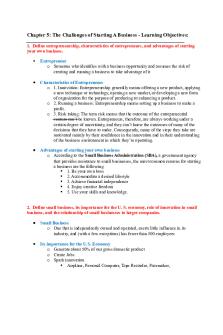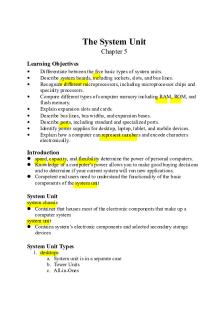Chapter 5 Notes PDF

| Title | Chapter 5 Notes |
|---|---|
| Course | General Microbiology |
| Institution | University of Hawaii at Manoa |
| Pages | 5 |
| File Size | 81.3 KB |
| File Type | |
| Total Downloads | 16 |
| Total Views | 149 |
Summary
Covers chapter 5 of microbiology...
Description
MICROBIOLOGY 130 - CHAPTER 5 WORKSHEET 1. What is the metabolism of an cell/organism? -The sum of all chemical reactions 2. Explain anabolism and catabolism in terms of: molecule complexity, energy change, ATP production/usage. •
Catabolism - the breakdown of compounds - generally yields energy = exergonic - hydrolysis often
•
Anabolism - the build up of compounds - requires the input of energy = endergonic - dehydration synthesis reactions are common
3. Why are numerous enzymes used in a multistep metabolic pathway? - Enzymatic activity allows a cell to respond to changing environmental demands and regulate its metabolic pathways, both of which are essential to cell survival.
4. Name 3 things that affect the rate of an enzymatic (or chemical) reaction. -Energy of reactants, speed, electron configuration, Orientation
5. Explain 4 characteristics of enzymes. -Proteins that perform reactions -They are biological catalysts - speed up to reaction rate -Not altered/consumed by the reaction -Lower the energy of activation
6. What are the 2 common parts of an enzyme? -Globular protein part called apoenzyme (inactive) -Nonprotein part called cofactor (activator) 7. Name 4 things that can disrupt the ability of an enzyme to function. -Temperature, pH, inhibitors, substrate concentration
8. What is an active site, what is an allosteric site? -Allosteric: Allows molecules to either activate or inhibit enzyme activity -Active: Substrates bind
9. What is the difference between competitive and noncompetitive inhibition? -In competitive inhibition, the inhibitor binds directly to the active site of the enzyme. -In non-competitive inhibition, the inhibitor binds to a site on the enzyme that is allosteric site. 10. What is feedback inhibition, and why is it so efficient and elegant? -Feedback inhibition is a cellular control mechanism in which an enzyme's activity is inhibited by the enzyme's end product. This mechanism allows cells to regulate how much of an enzyme's end product is produced. 11. Explain what OIL RIG means, and how it relates to some chemical reactions. -OIL RIG = Oxidation-Reduction Reactions -Oxidation - removal of electrons -Reduction - gain of electrons -Redox reaction: An oxidation reaction paired with a reduction reaction 12. Electrons removed from food are typically given to carriers, name the common one and explain its 2 states. -The electron transport chain (ETC) is the major consumer of O2 in mammalian cells. The ETC passes electrons from NADH and FADH2 to protein complexes and mobile electron carriers. Coenzyme Q (CoQ) and cytochrome c (Cyt c) are mobile electron carriers in the ETC, and O2 is the final electron recipient. 13. In terms of chemical reactions, what we extract from food (besides building blocks and nutrients)? -Energy 14. What is oxidative phosphorylation, substrate-level phosphorylation, and photophosphorylation? -Oxidative phosphorylation: -Electrons are stripped = oxidation -Electrons given to shuttlers -Electrons are then passed to carriers on a membrane -Ultimately end up reducing oxygen -ATP is generated in the process = phosphorylation -In mitochodria or at bacterial p.m. -Substrate-level phosphorylation: -Pi donor is usually a substrate -Pi is directly added to ADP -Thus ATP is made CCC~Pi + SDP —> CCC + ATP -Photophosphorylation: -Occurs only in light trapping photosynthetic cells. -Light energy is converted to ATP when the transfer of electrons (oxidation) from chlorophyll pass through a system of carrier molecules
15. What is cellular respiration, what are the major phases, and is it aerobic or anaerobic? -Aerobic -This is when glucose and oxygen react to form ATP and water and carbon dioxide are released as byproducts -Phases: Glycolysis, Krebs Cycle, and Oxidative Phosphorylation
16. In a few sentences, summarize glycolysis (for example: location, involvement of oxygen, catalysts…) -Oxidized to pyruvate -2 ATP are consumed
17. What is the starting material of glycolysis, what is the ending material? -Glucose -Pyruvic Acid
18. In between the start and finish of glycolysis, what else is produced? -Breakdown of sugars (glucose) to produce energy. -Pyruvate, NADH twice, and two ATP -First half is energy investment and second half is energy payoff
19. What step occurs between glycolysis and the Kreb cycle, why is this important? - For each glucose molecule respired, the cycle reactions occur twice as two pyruvic acid molecules are formed. - It is the product, acetyl CoA, which enters the Krebs cycle.
20. In a few sentences, summarize the Krebs cycle (including the starting and ending products). -Oxidation of acetyl CoA produces NDH, FADH2, and ATP -Liberates CO2 as a waste
21. All the reducing power from glycolysis, and especially the Krebs cycle, then end up where in respiration? -Oxidation of Pyruvate
22. What are the general components of the electron transport chain and what do they do? -FMN, Fe-S centers, Coenzyme Q, and Cytochromes - b, cq, c, aa3
23. At the end of the ETC where do the electrons end up in aerobic respiration, what about anaerobic respiration? -Aerobic: The last electron carrier in the membrane transfers 2 electrons to half an oxygen molecule -Anaerobic: A molecule other than oxygen is used as the terminal electron acceptor in the electron transport chain
24. As electrons flow through the ETC, what else is occurring? -H+ are translocated across the membrane -Energy released is used to produce ATP by chemiosmosis
25. As hydrogen ion build up on the external side of the ETC, what happens to them? Why can’t they simply diffuse back across the membrane. -H+ are translocated across the membrane
26. A chemiosmotic potential has been built, now describe how ATP synthase works. -H+ cannot pass membrane but at 1 point = ATP synthase -H+ flows through turning them into ATP synthase complex -As ATP synthase turns, it grabs ADP + P and locks the two to form ATP
27. Where does the ETC occur in bacteria, what about humans? All enzymes required for the electron transport chain of bacteria are membrane bound as in eukaryotic cells, but in bacteria these molecules are present in the plasma membrane because bacteria have no mitochondria.F
28. What are two differences between cellular respiration and fermentation? -Cellular respiration results in the complete oxidation of glucose into CO2 and water. Fermentation, on the other hand, does not fully oxidize glucose. Instead, small, reduced organic molecules are produced as waste. As a result, cellular respiration releases
29. Name 2 very useful products derived from fermentation. --Lactic acid and alcohol fermentations
30. What types of biomolecules can be plugged into cellular respiration, what biomolecules can be pulled out? Molecules in the cellular respiration pathway can be pulled out at many stages and used to build other molecules, including amino acids, nucleotides, lipids, and carbohydrates....
Similar Free PDFs

Chapter 5 - Lecture notes 5
- 15 Pages

Chapter-5 - Lecture notes 5
- 6 Pages

Chapter 5 - Lecture notes 5
- 83 Pages

Chapter 5 - Lecture notes 5
- 4 Pages

Chapter 5 - Lecture notes 5
- 20 Pages

Chapter 5 - Lecture notes 5
- 4 Pages

Chapter 5 - Lecture notes 5
- 7 Pages

Chapter 5 - Lecture notes 5
- 2 Pages

Chapter 5 - Lecture notes 5
- 3 Pages

Chapter 5 - Lecture notes 5
- 2 Pages

Chapter 5 - Lecture notes 5
- 6 Pages

Chapter 5 - Lecture notes 5
- 6 Pages

Chapter+5 - notes for chapter 5
- 8 Pages

Chapter 5 Notes 4e
- 12 Pages

Chapter 5 Notes
- 15 Pages

Chapter notes 1-5
- 72 Pages
Popular Institutions
- Tinajero National High School - Annex
- Politeknik Caltex Riau
- Yokohama City University
- SGT University
- University of Al-Qadisiyah
- Divine Word College of Vigan
- Techniek College Rotterdam
- Universidade de Santiago
- Universiti Teknologi MARA Cawangan Johor Kampus Pasir Gudang
- Poltekkes Kemenkes Yogyakarta
- Baguio City National High School
- Colegio san marcos
- preparatoria uno
- Centro de Bachillerato Tecnológico Industrial y de Servicios No. 107
- Dalian Maritime University
- Quang Trung Secondary School
- Colegio Tecnológico en Informática
- Corporación Regional de Educación Superior
- Grupo CEDVA
- Dar Al Uloom University
- Centro de Estudios Preuniversitarios de la Universidad Nacional de Ingeniería
- 上智大学
- Aakash International School, Nuna Majara
- San Felipe Neri Catholic School
- Kang Chiao International School - New Taipei City
- Misamis Occidental National High School
- Institución Educativa Escuela Normal Juan Ladrilleros
- Kolehiyo ng Pantukan
- Batanes State College
- Instituto Continental
- Sekolah Menengah Kejuruan Kesehatan Kaltara (Tarakan)
- Colegio de La Inmaculada Concepcion - Cebu